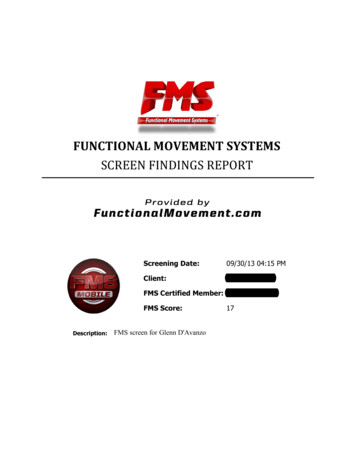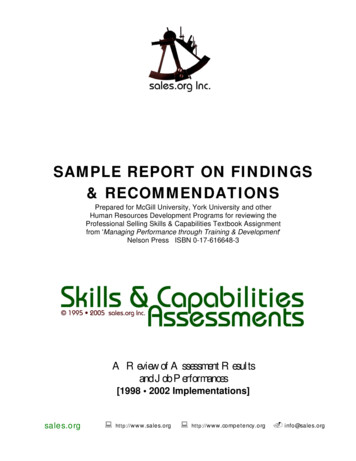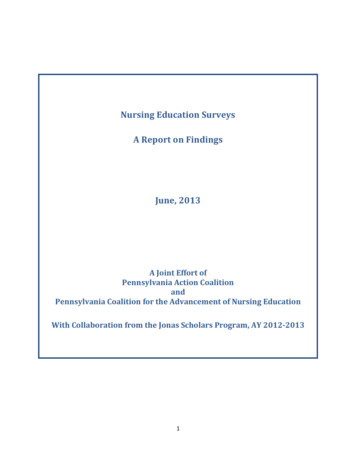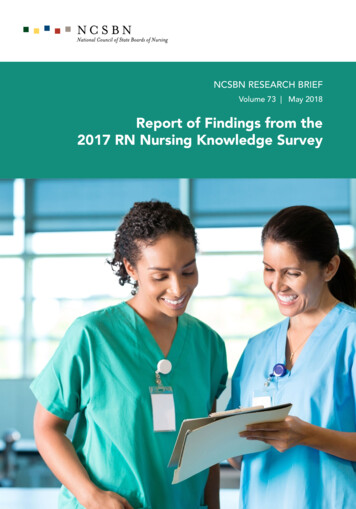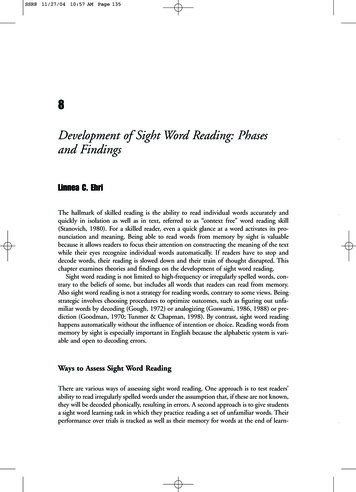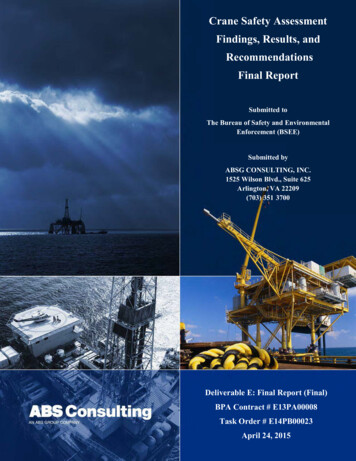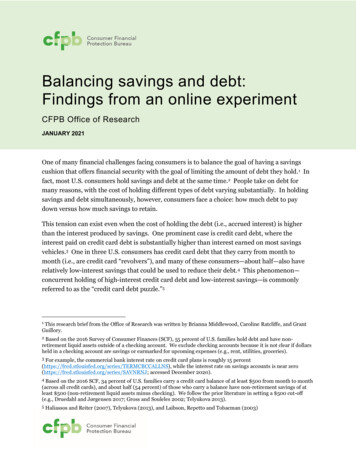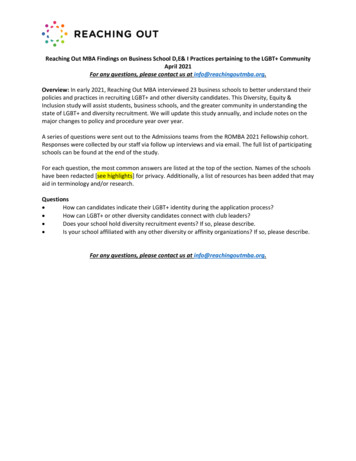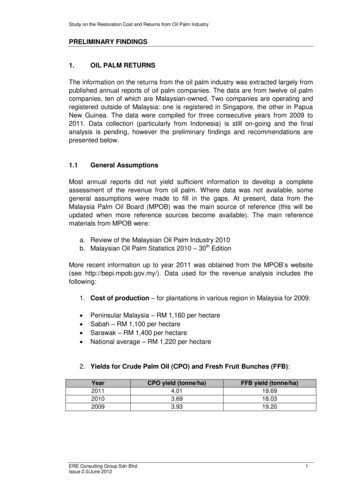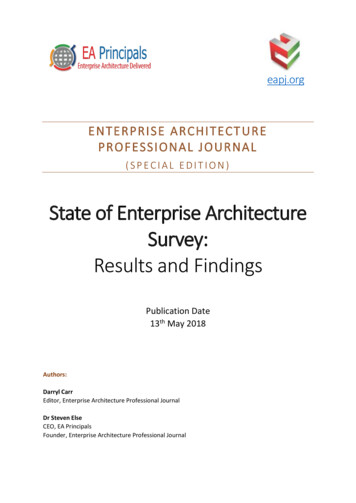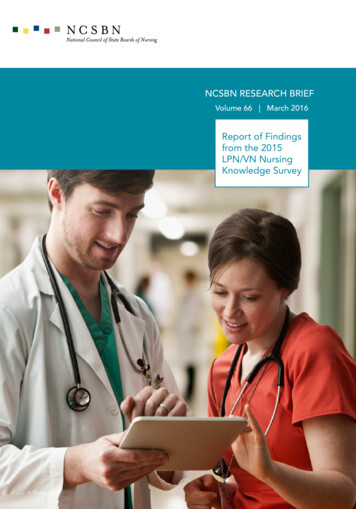
Transcription
NCSBN research briefVolume 66 March 2016Report of Findingsfrom the 2015LPN/VN NursingKnowledge Survey
Report of Findings from the2015 LPN/VN Nursing Knowledge SurveyNational Council of State Boards of Nursing, Inc. (NCSBN )
Mission StatementThe National Council of State Boards of Nursing (NCSBN ) provides education, service and research through collaborativeleadership to promote evidence-based regulatory excellence for patient safety and public protection.Copyright 2016 National Council of State Boards of Nursing, Inc. (NCSBN )All rights reserved. NCSBN , NCLEX , NCLEX-RN , NCLEX-PN , NNAAP , MACE , Nursys and TERCAP are registeredtrademarks of NCSBN and this document may not be used, reproduced or disseminated to any third party without writtenpermission from NCSBN.Permission is granted to boards of nursing to use or reproduce all or parts of this document for licensure related purposesonly. Nonprofit education programs have permission to use or reproduce all or parts of this document for educationalpurposes only. Use or reproduction of this document for commercial or for-profit use is strictly prohibited. Any authorizedreproduction of this document shall display the notice: “Copyright by the National Council of State Boards of Nursing,Inc. All rights reserved.” Or, if a portion of the document is reproduced or incorporated in other materials, such writtenmaterials shall include the following credit: “Portions copyrighted by the National Council of State Boards of Nursing,Inc. All rights reserved.”Address inquiries in writing to NCSBN Permissions, 111 E. Wacker Drive, Suite 2900, Chicago, IL 606014277. Suggested Citation: National Council of State Boards of Nursing. (2016). Report of Findings from the2015 LPN/VN Nursing Knowledge Survey. Chicago: Author.ISBN# 978-0-9903603-2-2
TABLE OF CONTENTSiTable of ContentsList of Tables iiiList of Figures ivExecutive Summary 1Background of Study 9Methodology 9Methodology Reviewers 9Panel of SMEs 9Survey Development 9Survey Process 10Summary 13Demographics, Experiences and Practice Environments of Participants 14Demographics/Past Experiences 14Nursing Licenses Held 14Gender 14Survey Adequacy 14Age 14Race/Ethnic Background 14Education Background 15Primary Language 15Years of Experience 18Facilities 18Client Health Conditions 18Client Ages 18Employment Setting/Specialty 22Summary 22Knowledge Statement Findings 23Overview of Methods 23SME Panel Validation of Survey Findings 23Representativeness of Knowledge Statements 23Reliability of Instrument 23Knowledge Statements 23Importance of Knowledge Statements 23Knowledge Statement Subgroup Analysis 23Primary Job Title 23Facility 35Summary 35Conclusions 36References 37Appendix A: 2015 Knowledge Survey Methodology Reviewers 38Appendix B: Subject Matter Expert Panel for the 2015 Knowledge OfNewly Licensed LPN/VN Survey 39National Council of State Boards of Nursing, Inc. (NCSBN) 2016
iiTABLE OF CONTENTSAppendix C: 2015 Knowledge of Newly Licensed LPN/VN Survey 41Appendix D: SME Knowledge Statement Ratings Rank Ordered By Average Importance 55Appendix E: Newly Licensed LPN/VN And SME Knowledge Statement RatingsRank Ordered By Newly Licensed LPN/VN Average Importance 63Appendix F: LPN/VN Educators and SME Knowledge Statement RatingsRank Ordered By LPN/VN Educator Average Importance 71Appendix G: LPN/VN Supervisors and SME Knowledge Statement RatingsRank Ordered By LPN/VN Supervisor Average Importance 79Appendix H: Knowledge Statements Subgroup Analysis: Primary Job Title 87Appendix I: Knowledge Statements Subgroup Analysis: Facility 98Appendix J: Knowledge Survey Nonresponder Study 107Appendix K: Linking of Knowledge Statements and Activity Statements 110National Council of State Boards of Nursing, Inc. (NCSBN) 2016
LIST OF TABLESiiiList of TablesTable 1. Representativeness of Responders by NCSBN Jurisdiction 11Table 2. Adjusted Return Rates 13Table 3. Analyzable Return Rates 13Table 4. Educational Background by Primary Job Title 17Table 5. Employment Setting/Specialty by Primary Job Title 20Table 6. Most Important and Least Important Knowledge Statements with Ratings 24Table 7. Most Important Knowledge Statements from 2015 and 2012 Surveys 25Table 8. Least Important Knowledge Statements from 2015 and 2012 Surveys 25Table 9. Knowledge Statement Importance Ratings 26Table J.1. Employment Setting/Specialty for Responders and Nonresponders 109Table J.2. Importance Ratings for Knowledge Statements 109National Council of State Boards of Nursing, Inc. (NCSBN) 2016
ivLIST OF FIGURESList of FiguresFigure 1. Licenses by Primary Job Title . . . . . . . . . . . . . . . . . . . . . . . . . . . . . . . . . . . . . . . . . . . . . . . . 14Figure 2. Gender by Primary Job Title. . . . . . . . . . . . . . . . . . . . . . . . . . . . . . . . . . . . . . . . . . . . . . . . . 15Figure 3. Survey Adequacy by Primary Job Title. . . . . . . . . . . . . . . . . . . . . . . . . . . . . . . . . . . . . . . . . 15Figure 4. Race/Ethnic Background by Primary Job Title. . . . . . . . . . . . . . . . . . . . . . . . . . . . . . . . . . . 16Figure 5. Primary Language by Primary Job Title . . . . . . . . . . . . . . . . . . . . . . . . . . . . . . . . . . . . . . . . 17Figure 6. Facility by Primary Job Title . . . . . . . . . . . . . . . . . . . . . . . . . . . . . . . . . . . . . . . . . . . . . . . . . 18Figure 7. Client Health Conditions by Primary Job Title. . . . . . . . . . . . . . . . . . . . . . . . . . . . . . . . . . . 19Figure 8. Client Ages by Primary Job Title. . . . . . . . . . . . . . . . . . . . . . . . . . . . . . . . . . . . . . . . . . . . . . 20Figure J.1. Reasons for Not Responding. . . . . . . . . . . . . . . . . . . . . . . . . . . . . . . . . . . . . . . . . . . . . . 108Figure J.2. Months at Position by Job Title. . . . . . . . . . . . . . . . . . . . . . . . . . . . . . . . . . . . . . . . . . . . 108National Council of State Boards of Nursing, Inc. (NCSBN) 2016
EXECUTIVE SUMMARYExecutive SummaryThe National Council of State Boards of Nursing(NCSBN ) is responsible to its members, the boardsof nursing in the U.S. and member board territoriesfor the preparation of psychometrically sound andlegally defensible licensure examinations (American Educational Research Association, AmericanPsychological Association and National Council onMeasurement in Education, 2014). Practice analysisstudies assist NCSBN in evaluating the validity ofthe test plan that guides content distribution of thelicensure examination. Because changes can occurin licensed practical/vocational nurse (LPN/VN)practice, NCSBN conducts practice analysis studiesevery three years.The primary purpose of this study is to identify theknowledge needed by newly licensed LPN/VNs. Theresults of this study (i.e., the important knowledgestatements) will be used to inform item development. As with other new NCSBN research projects,there is a possibility that the knowledge statementsmay become an integral part of other processes(e.g., test specifications). However, at this time,these knowledge statements will be used solely toinform item development.MethodologyA number of steps are necessary to perform ananalysis of the knowledge needed by newly licensedLPN/VNs. This section provides a description of themethodology used to conduct the 2015 LPN/VNNursing Knowledge Survey. Descriptions of thesubject matter expert (SME) panel processes, surveydevelopment, sample selection and data collectionprocedures are provided, as well as informationabout confidentiality, response rates and thedegree to which participants were representativeof the sample of Newly Licensed LPN/VNs, LPN/VNEducators, and LPN/VN Supervisors.Methodology ReviewersThere were three methodology reviewers, chosenfor their psychometric expertise in practice/jobanalysis and certification exam development, whoreviewed the methodologies and procedures utilized in this study. All three reviewers indicated this1methodology was psychometrically sound, legallydefensible and in compliance with professional testing standards.Panel of Subject Matter Experts (SMEs)A panel of seven SMEs was assembled to assistwith the creation of the knowledge statements andsurvey. Panel members taught LPN/VN students,supervised newly licensed LPN/VNs or were newlylicensed LPN/VNs themselves. The panelists alsorepresented the four NCSBN geographic areas, aswell as the major nursing specialties and practicesettings.Survey DevelopmentA number of processes were used to create, evaluate and refine the survey instrument used for the2015 LPN/VN Nursing Knowledge Survey. In theinitial meetings for the triennial practice analysis, apanel of nurses, representing different geographicregions of the country, nursing specialties and practice settings, met and developed nursing activitystatements, which were intended to represent newlylicensed LPN/VN practice. These activity statementsand the category structure developed by the SMEsprovided a categorical structure for the creation ofthe knowledge statements. Following the work ofthe first panel, a second group of SMEs was convened with two panelists bridging the two groups.This second panel reviewed the activity statementsas provided and then developed knowledge statements for each activity statement. The knowledgestatements are intended to provide more detailedinformation regarding the knowledge needed bynewly licensed LPN/VNs in order to perform nursingactivities. The knowledge statements were reviewedand edited by the NCLEX Examination Committee(NEC). The resulting 293 knowledge statementswere incorporated into a survey format.The final version of the survey contained several initial questions to identify responder characteristicsand then four sections. The first section focused onthe knowledge necessary for newly licensed LPN/VNpractice, asking responders to rate the importanceof each knowledge statement by using a one to fivepoint scale. Section two identified the participant’sNational Council of State Boards of Nursing, Inc. (NCSBN) 2016
2EXECUTIVE SUMMARYwork environment including area of practice, agesof client, and employment setting/specialty. Sectionthree focused on demographic information such asracial/ethnic background, highest obtained education degree, and gender. The final section providedspace for responders to write comments or suggestions about the survey.Survey ProcessSample SelectionNewly Licensed LPN/VNs: A random sample of2,150 LPN/VNs was selected from a list of candidateswho passed the NCLEX-PN examination betweenJan. 15, 2015 and March 31, 2015 and did notparticipate in the LPN/VN Practice Analysis survey.Only candidates with a U.S. mailing address withinthe jurisdiction in which they were seeking licensurewere included in the sample. This strategy provideda way to minimize the number of incorrect addressesto which the survey would be sent.Educators of LPN/VNs (LPN/VN Educators): In addition, surveys were sent to 2,100 LPN/VN Educatorsat 700 different nursing programs. Three surveyswere sent to each dean/director of 700 nursing programs with instructions for them to distribute onesurvey to (1) a Medical/Surgical nursing instructor;(2) an Obstetrics-Gynecology/Pediatric nursinginstructor; and (3) a Mental Health or CommunityHealth nursing instructor. Each of the programs inthe sample had a minimum of nine NCLEX candidates within the last two calendar years (2013 and2014). In the event that there were faculty membersunable to complete the survey, the dean/directorswere asked to give the survey to additional Medical/Surgical faculty members.Supervisors of Newly Licensed LPN/VNs (LPN/VNSupervisor): Finally, 2,100 employers (700 in nursinghomes; 700 in hospitals; and 700 in home healthagencies) of newly licensed LPN/VNs were surveyed. This list came from a substantially largermailing list, but the selection of employers to beincluded in the survey was also based upon thenumber of LPN/VN employees working for the facility. This criterion was applied in order to maximizethe likelihood that the employer would have newlylicensed LPN/VNs and supervisors of newly licensedLPN/VNs. Surveys were mailed to the directors ofnursing (DON) or an equivalent title at 2,100 healthcare facilities mentioned previously. The DONswere asked to complete the survey if they directlysupervised newly licensed LPN/VNs. If they did notsupervise newly licensed LPN/VNs, the DONs wereasked to give the survey to a nurse who did supervise newly licensed LPN/VNs.RepresentativenessBecause multiple surveys were sent to LPN/VNEducators of the same institution, all responders from an institution were counted as one in therepresentativeness calculation. The percentage ofresponders from the various NCSBN member boardjurisdictions is similar to the sample composition.Mailing ProcedureThe survey forms were mailed to a total of 6,350potential responders (2,150 Newly LicensedLPN/VNs, 700 nursing programs, which includedsurveys for three educators [2,100 LPN/VN Educatorsin total] and 700 nursing homes, 700 hospitalsand 700 home health agencies [2,100 potentialsupervisors of newly licensed LPN/VNs]). To acquirethe LPN/VN Educator responders, three surveyswere sent to the dean/director of the program todistribute amongst their staff. It was requested thata survey be distributed to an educator in each ofthe following general areas: (1) Medical/SurgicalNursing; (2) Obstetrics-Gynecology/Pediatric orMaternal Child Nursing; and (3) Mental Healthor Community Health Nursing. If the school didnot have specialty faculty who could completethe survey, it was asked that additional faculty inthe clinical setting who teach Medical/Surgicalparticipate.A five-stage mailing process was used to engagethe participants in the study. A pre-survey letter wassent to each person or facility selected for the sample. One week later, the survey(s), with a cover letterand a postage-paid return envelope, were mailed.Eleven days later, a postcard was sent t
Nursing Knowledge Survey Descriptions of the subject matter expert (SME) panel processes, survey development, sample selection and data collection procedures are provided, as well as information about confidentiality, response rates and the degree to which participants were repre
